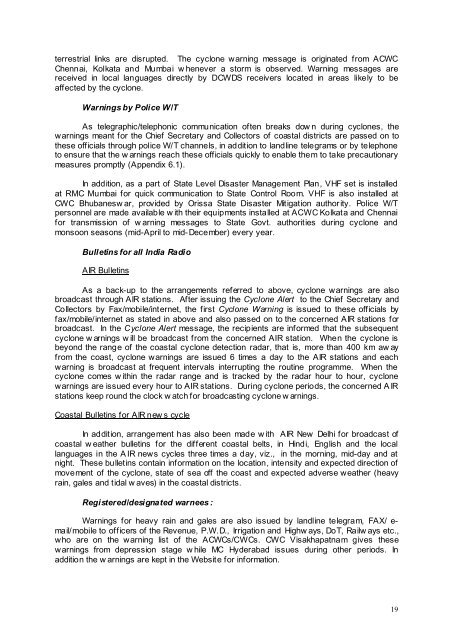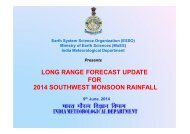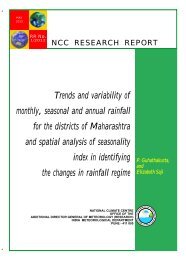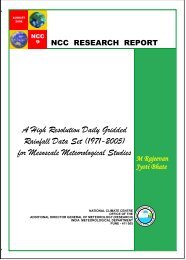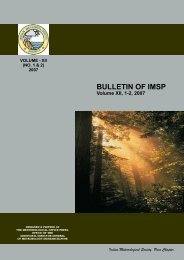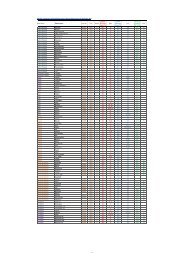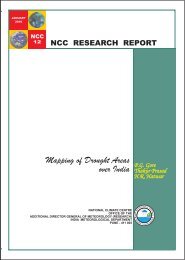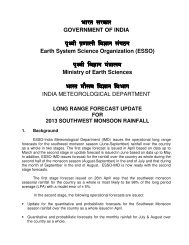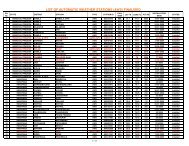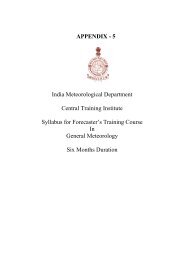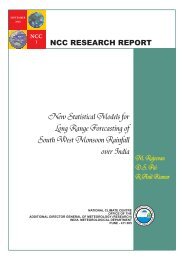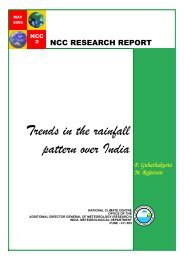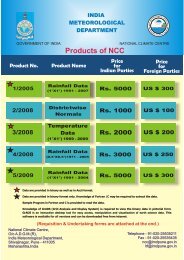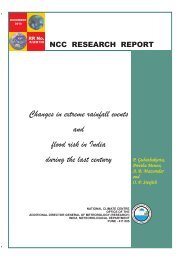Forecasters Guide - (IMD), Pune
Forecasters Guide - (IMD), Pune
Forecasters Guide - (IMD), Pune
You also want an ePaper? Increase the reach of your titles
YUMPU automatically turns print PDFs into web optimized ePapers that Google loves.
terrestrial links are disrupted. The cyclone warning message is originated from ACWC<br />
Chennai, Kolkata and Mumbai w henever a storm is observed. Warning messages are<br />
received in local languages directly by DCWDS receivers located in areas likely to be<br />
affected by the cyclone.<br />
Warnings by Police W/T<br />
As telegraphic/telephonic communication often breaks dow n during cyclones, the<br />
warnings meant for the Chief Secretary and Collectors of coastal districts are passed on to<br />
these officials through police W/T channels, in addition to landline telegrams or by telephone<br />
to ensure that the w arnings reach these officials quickly to enable them to take precautionary<br />
measures promptly (Appendix 6.1).<br />
In addition, as a part of State Level Disaster Management Plan, VHF set is installed<br />
at RMC Mumbai for quick communication to State Control Room. VHF is also installed at<br />
CWC Bhubanesw ar, provided by Orissa State Disaster Mitigation authority. Police W/T<br />
personnel are made available w ith their equipments installed at ACWC Kolkata and Chennai<br />
for transmission of w arning messages to State Govt. authorities during cyclone and<br />
monsoon seasons (mid-April to mid-December) every year.<br />
Bulletins for all India Radio<br />
AIR Bulletins<br />
As a back-up to the arrangements referred to above, cyclone warnings are also<br />
broadcast through AIR stations. After issuing the Cyclone Alert to the Chief Secretary and<br />
Collectors by Fax/mobile/internet, the first Cyclone Warning is issued to these officials by<br />
fax/mobile/internet as stated in above and also passed on to the concerned AIR stations for<br />
broadcast. In the Cyclone Alert message, the recipients are informed that the subsequent<br />
cyclone w arnings w ill be broadcast from the concerned AIR station. When the cyclone is<br />
beyond the range of the coastal cyclone detection radar, that is, more than 400 km aw ay<br />
from the coast, cyclone warnings are issued 6 times a day to the AIR stations and each<br />
warning is broadcast at frequent intervals interrupting the routine programme. When the<br />
cyclone comes w ithin the radar range and is tracked by the radar hour to hour, cyclone<br />
warnings are issued every hour to AIR stations. During cyclone periods, the concerned A IR<br />
stations keep round the clock w atch for broadcasting cyclone w arnings.<br />
Coastal Bulletins for AIR new s cycle<br />
In addition, arrangement has also been made w ith AIR New Delhi for broadcast of<br />
coastal w eather bulletins for the different coastal belts, in Hindi, English and the local<br />
languages in the A IR news cycles three times a day, viz., in the morning, mid-day and at<br />
night. These bulletins contain information on the location, intensity and expected direction of<br />
movement of the cyclone, state of sea off the coast and expected adverse weather (heavy<br />
rain, gales and tidal w aves) in the coastal districts.<br />
Registered/designated warnees :<br />
Warnings for heavy rain and gales are also issued by landline telegram, FAX/ e-<br />
mail/mobile to officers of the Revenue, P.W.D., Irrigation and Highw ays, DoT, Railw ays etc.,<br />
who are on the warning list of the ACWCs/CWCs. CWC Visakhapatnam gives these<br />
warnings from depression stage w hile MC Hyderabad issues during other periods. In<br />
addition the w arnings are kept in the Website for information.<br />
19


